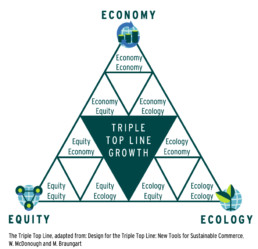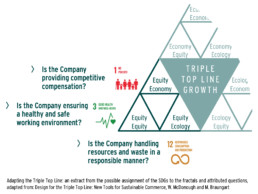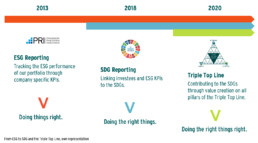The integration of ESG (Environmental, Social, and Governance) factors into investment processes and decision making has seen tremendous growth in recent years. Additionally, with the investment world adopting an active role in achieving the UN Sustainable Development Goals (SDGs), we see a rising need for a framework enabling sustainable and quantifiable value creation as well as a straightforward implementation. We believe to have found the solution in the Triple Top Line. But first, let’s see why the Triple Top Line excellently meets today’s Zeitgeist and how it takes our sustainability practices to the next level.
> The rise of ESG < Investors trimming their portfolios for sustainability, food manufacturers praising the CO2 neutrality of their production, or companies marketing their coal phase-out planned for the next two decades, are all to be understood as reactions to changing customer needs and – ultimately – as a fight for legitimacy and survival. The race for sustainability just entered a new dimension.
There is no doubt that industrialization has contributed to social welfare by supplying high-quality products adapted to human necessities as well as by ensuring the right working conditions for employees. But our globalized system also made it easier for some companies to plunder natural resources, exploit cheap labor, and exacerbate the inequality of wealth by earning profits from their operations in less developed countries and distributing them to their shareholders in wealthier ones. But these times are coming to an end. With our society facing extreme challenges such as climate change, infectious diseases, and resource scarcity, our economies will have to undergo a profound structural change and companies will have to take action.
And many of them already did. 2019 could certainly be called „The Year of ESG” (Environmental, Social, and Governance), with daily announcements from companies having implemented ESG criteria, having reached 30+ of ESG key performance indicators (KPIs), or having achieved 100% ESG conformity. This comes slightly delayed, but is a step in the right direction and is actually based on scienetific results. A study conducted by Harvard Business School’s Serafeim showed that companies having developed organizational processes to measure their ESG performance in the early 1990s outperformed a carefully matched control group over the next 18 years. Similar results are provided by Nordea Equity Research as well. And let’s not forget customers for whom ESG compliance is not an option anymore – but a duty.
As a signatory of the UN Principles for Responsible Investment (UNPRI), Munich Venture Partners (MVP) has a longstanding history in measuring the impact of its portfolio through company specific ESG KPIs. Besides learning a lot about our investees’ operations, our ESG experience also taught us why ESG is a perfect tool for negative screening and early risk identification but incomplete when it comes to outlining the whole impact of our portfolio. Particularly by mainly focusing on the past (12 months’) performance, ESG neglects the huge potential of early-stage companies, which just might need some additional years to be able to shine with huge numbers. Moreover, by separately tracking environmental, social, and governance factors, ESG neglects the interaction between these pillars and misses out the impact of each on the other.
> Taking one step at a time < Unlike ESG – which by establishing policies and processes guarantees a minimum level of sustainability, the UN Sustainable Development Goals (SDGs) are more output oriented and illustrate how investment decisions impact the broader environment and society as a whole. As we believe this better reflects the fast-paced and future-oriented Venture Capital sector, we decided already in 2018 to go beyond the standard ESG approach and linked the E/S/G KPIs we have been tracking to the SDGs. We are thereby guiding our investees towards long-term orientation and focusing on the road that lies ahead.
However, we see a rising need for an assessment framework which can deal with individual requirements, may it be startups, venture capitalists, or fund investors, the complex structure of the SDGs, and – above all – their holistic nature, meaning that all goals must be achieved in unison. To put it another way – if we want to achieve the SDGs by 2030, we need to get structure in our impact assessment. But how?
> Adapting the past < Developed 25 years ago, the Triple Bottom Line seemed to be the answer to increasing pressure on organizations to deliver performance that is socially equitable, environmentally responsible, and economically sound. These Triple Bottom Line domains of People, Planet, and Profit have defined long-term strategies of global corporations and have shaped the view that to be truly sustainable, a balance must be struck between all three. However, by purely focusing on the management of negative effects, the approach has also been criticized for missing out many opportunities of innovation and value creation.
> Introducing the Triple Top Line < Whereas the Triple Bottom Line mantains an aging system by reducing its negative impacts, the Triple Top Line concept developed by W. McDonough and M. Braungart builds the foundation of a new one, which rather than balancing economic, ecological, and social equity targets, chooses to employ their dynamic interplay to concurrently generate value on all pillars.
The Triple Top Line is embodied in a fractal triangle. When using this tool, the starting point is the top corner[i] of Economy – Economy as the first aspect to be considered is whether a product can be offered at a profit or not. If that is not the case, the process ends here due to lacking economic viability. Otherwise, one can start moving around the fractals and examine how progress can be generated in each. In W. McDonough and M. Braungart’s model this is attained through questions as: Will our production process use resources efficiently? Are we finding new ways to honor everyone involved, regardless of race, sex, nationality, or religion?

> Using the Triple Top Line < Our first step in implementing the Triple Top Line into the Venture Capital world meant translating the SDGs into investible opportunities and linking them to the fractals of the Triple Top Line. Inspired by the original model, we then elaborated our own set of questions for each fractal. We thereby took into account the value creation opportunity in the respective fractal as well as the sub-targets of the assigned SDG(s).
By condensing it down to 9 simple questions – one for each fractal – and deriving tangible measures and KPIs out of these, we found a straightforward way of implementing the Triple Top Line on a portfolio company level.
We use the Triple Top Line both pre-investment, to evaluate startups as part of our Due Diligence processes, as well as during the active holding period, as a very effective controlling and guidance tool. On a yearly basis we evaluate the progress achieved by our investees in each fractal, analyze where there is still room for improvement, and set new targets. Additionally, an underlying scoring system enables us to track and compare the progress of our portfolio companies.
Through this mechanism we adhere to one of the guiding principles of the Triple Top Line: Be efficient and effective. Effectiveness means doing the right things – which for us translates into contributing to the SDGs – while efficiency means doing things the right way – which we ensure through our KPIs.


> What we particularly like about the Triple Top Line < The Triple Top Line aims for a sustainable industrial system, generating economic returns while enhancing nature and society. By concurrently maximizing value on all three pillars, the Triple Top Line points out that economic growth, environmental gains, and societal value creation are not only interconnected but mutually reinforcing each other. By using the Triple Top Line, we can assure that our investments are contributing to the SDGs in a holistic manner and with quantifiable results. For us and our fund investors this translates into over-proportional financial returns accompanied by value creation on two additional pillars.
By narrowing it down to 9 simple questions and derived targets, we enable our portfolio companies to focus on high-leverage measures without losing sight of the big picture. Additionally, rather than using their resources to report on umpteen KPIs, our portfolio companies can focus on identifiying the measures with the highest impact. For us, the adapted Triple Top Line is a tool which enhances continuous progress through small – but very effective – steps and through clear targets.
> The window for action is open < The SDGs represent an urgent call for action. If we want to limit global warming within the acceptable range of 1-2°C compared to pre-industrial levels, meet the challenges of a growing population – and so many more – the main actions need to be triggered today.
Successful entrepreneurs have recognized that the most important ingredient for their secret sauce is a good relationship with society and the environment. These mission-driven leaders are just about to disrupt existing industries by leveraging technology and breakthrough innovations. Reduced emissions from a renewable-based energy sector, the rising uptake of shared mobility, and a more efficient manufacturing sector will lead to an increasingly decarbonized world, while IoT solutions within the food sector will reduce food waste and help us sustainably feed a growing population.
Many solutions are already out there, let’s put them into practice together.
[i] In the original model Economy is the bottom right corner






